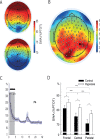Deepening sleep by hypnotic suggestion
- PMID: 24882909
- PMCID: PMC4015388
- DOI: 10.5665/sleep.3778
Deepening sleep by hypnotic suggestion
Abstract
Study objectives: Slow wave sleep (SWS) plays a critical role in body restoration and promotes brain plasticity; however, it markedly declines across the lifespan. Despite its importance, effective tools to increase SWS are rare. Here we tested whether a hypnotic suggestion to "sleep deeper" extends the amount of SWS.
Design: Within-subject, placebo-controlled crossover design.
Setting: Sleep laboratory at the University of Zurich, Switzerland.
Participants: Seventy healthy females 23.27 ± 3.17 y.
Intervention: Participants listened to an auditory text with hypnotic suggestions or a control tape before napping for 90 min while high-density electroencephalography was recorded.
Measurements and results: After participants listened to the hypnotic suggestion to "sleep deeper" subsequent SWS was increased by 81% and time spent awake was reduced by 67% (with the amount of SWS or wake in the control condition set to 100%). Other sleep stages remained unaffected. Additionally, slow wave activity was significantly enhanced after hypnotic suggestions. During the hypnotic tape, parietal theta power increases predicted the hypnosis-induced extension of SWS. Additional experiments confirmed that the beneficial effect of hypnotic suggestions on SWS was specific to the hypnotic suggestion and did not occur in low suggestible participants.
Conclusions: Our results demonstrate the effectiveness of hypnotic suggestions to specifically increase the amount and duration of slow wave sleep (SWS) in a midday nap using objective measures of sleep in young, healthy, suggestible females. Hypnotic suggestions might be a successful tool with a lower risk of adverse side effects than pharmacological treatments to extend SWS also in clinical and elderly populations.
Keywords: high-density EEG; hypnosis; sleep; slow wave sleep.
Figures




Similar articles
-
Hypnotic Suggestions Increase Slow-Wave Parameters but Decrease Slow-Wave Spindle Coupling.Nat Sci Sleep. 2021 Aug 6;13:1383-1393. doi: 10.2147/NSS.S316997. eCollection 2021. Nat Sci Sleep. 2021. PMID: 34393533 Free PMC article.
-
Improving sleep and cognition by hypnotic suggestion in the elderly.Neuropsychologia. 2015 Mar;69:176-82. doi: 10.1016/j.neuropsychologia.2015.02.001. Epub 2015 Feb 4. Neuropsychologia. 2015. PMID: 25660206 Clinical Trial.
-
HYPNOTIC SUGGESTIONS GIVEN BEFORE NIGHTTIME SLEEP EXTEND SLOW-WAVE SLEEP AS COMPARED TO A CONTROL TEXT IN HIGHLY HYPNOTIZABLE SUBJECTS.Int J Clin Exp Hypn. 2020 Jan-Mar;68(1):105-129. doi: 10.1080/00207144.2020.1687260. Int J Clin Exp Hypn. 2020. PMID: 31914371 Clinical Trial.
-
Slow-wave sleep deficiency and enhancement: implications for insomnia and its management.World J Biol Psychiatry. 2010 Jun;11 Suppl 1:22-8. doi: 10.3109/15622971003637645. World J Biol Psychiatry. 2010. PMID: 20509829 Review.
-
The visual scoring of sleep and arousal in infants and children.J Clin Sleep Med. 2007 Mar 15;3(2):201-40. J Clin Sleep Med. 2007. PMID: 17557427 Review.
Cited by
-
Behavioral and psychological treatments for NREM parasomnias: A systematic review.Sleep Med. 2023 Nov;111:36-53. doi: 10.1016/j.sleep.2023.09.004. Epub 2023 Sep 6. Sleep Med. 2023. PMID: 37716336 Free PMC article.
-
Embodiment of sleep-related words: Evidence from event-related potentials.Psychophysiology. 2021 Aug;58(8):e13824. doi: 10.1111/psyp.13824. Epub 2021 May 4. Psychophysiology. 2021. PMID: 33942324 Free PMC article.
-
Self-Hypnosis for Sleep Disturbances in Menopausal Women.J Womens Health (Larchmt). 2020 Mar;29(3):461-463. doi: 10.1089/jwh.2020.8327. J Womens Health (Larchmt). 2020. PMID: 32186967 Free PMC article. Clinical Trial.
-
Hypnotic Suggestions Increase Slow-Wave Parameters but Decrease Slow-Wave Spindle Coupling.Nat Sci Sleep. 2021 Aug 6;13:1383-1393. doi: 10.2147/NSS.S316997. eCollection 2021. Nat Sci Sleep. 2021. PMID: 34393533 Free PMC article.
-
Updated Review of the Acoustic Modulation of Sleep: Current Perspectives and Emerging Concepts.Nat Sci Sleep. 2021 Jul 24;13:1319-1330. doi: 10.2147/NSS.S284805. eCollection 2021. Nat Sci Sleep. 2021. PMID: 34335067 Free PMC article. Review.
References
-
- Ohayon MM, Vecchierini M-F. Normative sleep data, cognitive function and daily living activities in older adults in the community. Sleep. 2005;28:981–9. - PubMed
-
- Vorona RD, Winn MP, Babineau TW, Eng BP, Feldman HR, Ware JC. Overweight and obese patients in a primary care population report less sleep than patients with a normal body mass index. Arch Intern Med. 2005;165:25–30. - PubMed
-
- Newman AB, Enright PL, Manolio TA, Haponik EF, Wahl PW. Sleep disturbance, psychosocial correlates, and cardiovascular disease in 5201 older adults: the Cardiovascular Health Study. J Am Geriatr Soc. 1997;45:1–7. - PubMed
Publication types
MeSH terms
LinkOut - more resources
Full Text Sources
Other Literature Sources
Research Materials

